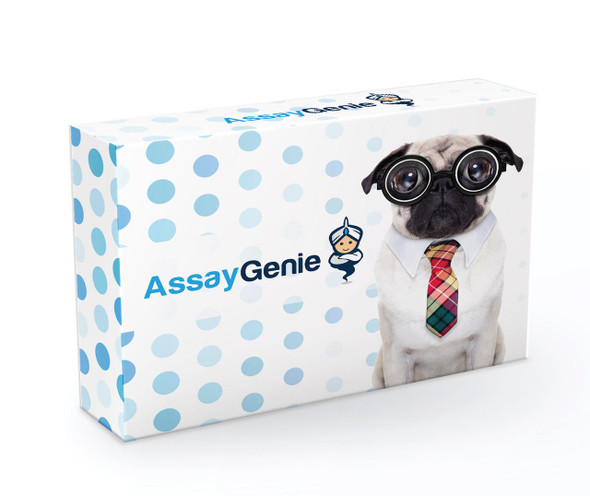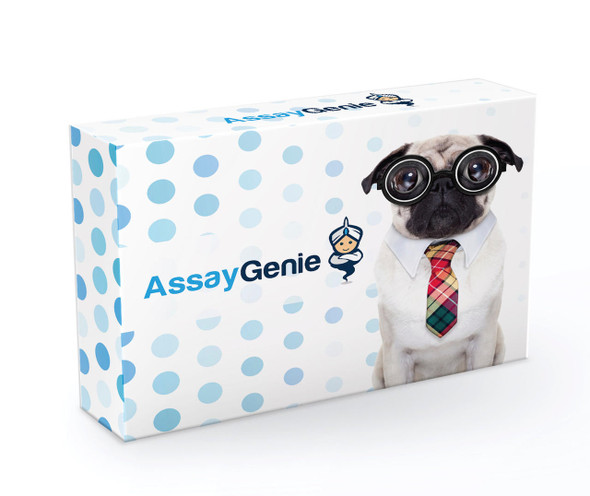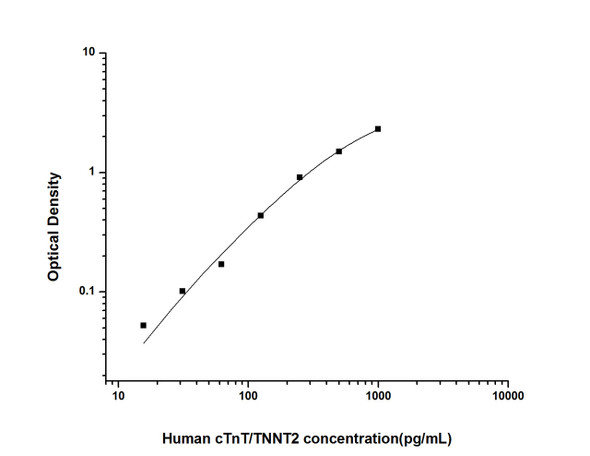Rat Signaling ELISA Kits 2
Rat cTnT/TNNT2 (Troponin T Type 2, Cardiac) CLIA Kit (RTES00089)
- SKU:
- RTES00089
- Product Type:
- ELISA Kit
- ELISA Type:
- CLIA Kit
- Size:
- 96 Assays
- Sensitivity:
- 4.69pg/mL
- Range:
- 7.81-500pg/mL
- ELISA Type:
- Sandwich
- Synonyms:
- CMH2, CMPD2, LVNC6, RCM3, TnTC
- Reactivity:
- Rat
- Sample Type:
- Serum, plasma and other biological fluids
Description
| Assay type: | Sandwich |
| Format: | 96T |
| Assay time: | 4.5h |
| Reactivity: | Rat |
| Detection method: | Chemiluminescence |
| Detection range: | 7.81-500 pg/mL |
| Sensitivity: | 4.69 pg/mL |
| Sample volume: | 100µL |
| Sample type: | Serum, plasma and other biological fluids |
| Repeatability: | CV < 15% |
| Specificity: | This kit recognizes Rat cTnT/TNNT2 in samples. No significant cross-reactivity or interference between Rat cTnT/TNNT2 and analogues was observed. |
This kit uses Sandwich-CLIA as the method. The micro CLIA plate provided in this kit has been pre-coated with an antibody specific to Rat cTnT/TNNT2. Standards or samples are added to the appropriate micro CLIA plate wells and combined with the specific antibody. Then a biotinylated detection antibody specific for Rat cTnT/TNNT2 and Avidin-Horseradish Peroxidase (HRP) conjugate are added to each micro plate well successively and incubated. Free components are washed away. The substrate solution is added to each well. Only those wells that contain Rat cTnT/TNNT2, biotinylated detection antibody and Avidin-HRP conjugate will appear fluorescence. The Relative light unit (RLU) value is measured spectrophotometrically by the Chemiluminescence immunoassay analyzer. The RLU value is positively associated with the concentration of Rat cTnT/TNNT2. The concentration of Rat cTnT/TNNT2 in the samples can be calculated by comparing the RLU of the samples to the standard curve.
| UniProt Protein Function: | TNNT2: Troponin T is the tropomyosin-binding subunit of troponin, the thin filament regulatory complex which confers calcium-sensitivity to striated muscle actomyosin ATPase activity. Heart. The fetal heart shows a greater expression in the atrium than in the ventricle, while the adult heart shows a greater expression in the ventricle than in the atrium. Isoform 6 predominates in normal adult heart. Isoforms 1, 7 and 8 are expressed in fetal heart. Isoform 7 is also expressed in failing adult heart. Belongs to the troponin T family. 11 isoforms of the human protein are produced by alternative splicing. |
| UniProt Protein Details: | Protein type:Motor; Motility/polarity/chemotaxis Cellular Component: sarcomere; troponin complex; myofibril; cytoplasm; striated muscle thin filament Molecular Function:protein binding, bridging; troponin C binding; structural constituent of cytoskeleton; troponin I binding; ATPase activity; tropomyosin binding; actin binding Biological Process: actin crosslink formation; regulation of muscle contraction; atrial cardiac muscle morphogenesis; protein heterooligomerization; metabolic process; heart development; regulation of muscle filament sliding speed; sarcomere organization; regulation of heart contraction; muscle filament sliding; muscle contraction; positive regulation of ATPase activity; ventricular cardiac muscle morphogenesis; response to calcium ion; negative regulation of ATPase activity; cardiac muscle contraction |
| NCBI Summary: | tropomyosin-binding subunit of troponin; confers calcium-sensitivy to actinomysin ATPase activity in striated muscle [RGD, Feb 2006] |
| UniProt Code: | P50753 |
| NCBI GenInfo Identifier: | 6981666 |
| NCBI Gene ID: | 24837 |
| NCBI Accession: | NP_036808. 1 |
| UniProt Related Accession: | P50753 |
| Molecular Weight: | 34,452 Da |
| NCBI Full Name: | troponin T, cardiac muscle |
| NCBI Synonym Full Names: | troponin T type 2 (cardiac) |
| NCBI Official Symbol: | Tnnt2 |
| NCBI Official Synonym Symbols: | Ctt; CTTG; Tnnt3; RATCTTG |
| NCBI Protein Information: | troponin T, cardiac muscle; cTnT; tnTc; Troponin T cardiac; cardiac troponin T2; troponin T2, cardiac; cardiac muscle troponin T |
| UniProt Protein Name: | Troponin T, cardiac muscle |
| UniProt Synonym Protein Names: | Cardiac muscle troponin T; cTnT |
| UniProt Gene Name: | Tnnt2 |
| UniProt Entry Name: | TNNT2_RAT |
As the RLU values of the standard curve may vary according to the conditions of the actual assay performance (e. g. operator, pipetting technique, washing technique or temperature effects), the operator should establish a standard curve for each test. Typical standard curve and data is provided below for reference only.
| Concentration (pg/mL) | RLU | Average | Corrected |
| 500 | 48212 54862 | 51537 | 51508 |
| 250 | 19095 22901 | 20998 | 20969 |
| 125 | 9587 9205 | 9396 | 9367 |
| 62.5 | 4217 4807 | 4512 | 4483 |
| 31.25 | 2379 2219 | 2299 | 2270 |
| 15.63 | 1263 1237 | 1250 | 1221 |
| 7.81 | 733 747 | 740 | 711 |
| 0 | 28 30 | 29 | -- |
Precision
Intra-assay Precision (Precision within an assay): 3 samples with low, mid range and high level Rat cTnT/TNNT2 were tested 20 times on one plate, respectively.
Inter-assay Precision (Precision between assays): 3 samples with low, mid range and high level Rat cTnT/TNNT2 were tested on 3 different plates, 20 replicates in each plate.
| Intra-assay Precision | Inter-assay Precision | |||||
| Sample | 1 | 2 | 3 | 1 | 2 | 3 |
| n | 20 | 20 | 20 | 20 | 20 | 20 |
| Mean (pg/mL) | 26.96 | 78.60 | 169.72 | 25.65 | 74.15 | 154.43 |
| Standard deviation | 2.99 | 7.05 | 16.41 | 2.71 | 5.40 | 13.84 |
| C V (%) | 11.09 | 8.97 | 9.67 | 10.57 | 7.28 | 8.96 |
Recovery
The recovery of Rat cTnT/TNNT2 spiked at three different levels in samples throughout the range of the assay was evaluated in various matrices.
| Sample Type | Range (%) | Average Recovery (%) |
| Serum (n=5) | 87-100 | 93 |
| EDTA plasma (n=5) | 87-102 | 94 |
| Cell culture media (n=5) | 93-108 | 101 |
Linearity
Samples were spiked with high concentrations of Rat cTnT/TNNT2 and diluted with Reference Standard & Sample Diluent to produce samples with values within the range of the assay.
| Serum (n=5) | EDTA plasma (n=5) | Cell culture media (n=5) | ||
| 1:2 | Range (%) | 86-96 | 103-121 | 100-113 |
| Average (%) | 91 | 110 | 105 | |
| 1:4 | Range (%) | 85-98 | 93-103 | 84-96 |
| Average (%) | 91 | 98 | 90 | |
| 1:8 | Range (%) | 104-119 | 97-108 | 87-101 |
| Average (%) | 110 | 103 | 93 | |
| 1:16 | Range (%) | 84-95 | 97-113 | 89-101 |
| Average (%) | 90 | 103 | 94 |
An unopened kit can be stored at 4°C for 1 month. If the kit is not used within 1 month, store the items separately according to the following conditions once the kit is received.
| Item | Specifications | Storage |
| Micro CLIA Plate(Dismountable) | 8 wells ×12 strips | -20°C, 6 months |
| Reference Standard | 2 vials | |
| Concentrated Biotinylated Detection Ab (100×) | 1 vial, 120 µL | |
| Concentrated HRP Conjugate (100×) | 1 vial, 120 µL | -20°C(shading light), 6 months |
| Reference Standard & Sample Diluent | 1 vial, 20 mL | 4°C, 6 months |
| Biotinylated Detection Ab Diluent | 1 vial, 14 mL | |
| HRP Conjugate Diluent | 1 vial, 14 mL | |
| Concentrated Wash Buffer (25×) | 1 vial, 30 mL | |
| Substrate Reagent A | 1 vial, 5 mL | 4°C (shading light) |
| Substrate Reagent B | 1 vial, 5 mL | 4°C (shading light) |
| Plate Sealer | 5 pieces | |
| Product Description | 1 copy | |
| Certificate of Analysis | 1 copy |
- Set standard, test sample and control (zero) wells on the pre-coated plate and record theirpositions. It is recommended to measure each standard and sample in duplicate. Note: addall solutions to the bottom of the plate wells while avoiding contact with the well walls. Ensuresolutions do not foam when adding to the wells.
- Aliquot 100µl of standard solutions into the standard wells.
- Add 100µl of Sample / Standard dilution buffer into the control (zero) well.
- Add 100µl of properly diluted sample (serum, plasma, tissue homogenates and otherbiological fluids. ) into test sample wells.
- Cover the plate with the sealer provided in the kit and incubate for 90 min at 37°C.
- Aspirate the liquid from each well, do not wash. Immediately add 100µL of BiotinylatedDetection Ab working solution to each well. Cover the plate with a plate seal and gently mix. Incubate for 1 hour at 37°C.
- Aspirate or decant the solution from the plate and add 350µL of wash buffer to each welland incubate for 1-2 minutes at room temperature. Aspirate the solution from each well andclap the plate on absorbent filter paper to dry. Repeat this process 3 times. Note: a microplatewasher can be used in this step and other wash steps.
- Add 100µL of HRP Conjugate working solution to each well. Cover with a plate seal andincubate for 30 min at 37°C.
- Aspirate or decant the solution from each well. Repeat the wash process for five times asconducted in step 7.
- Add 100µL of Substrate mixture solution to each well. Cover with a new plate seal andincubate for no more than 5 min at 37°C. Protect the plate from light.
- Determine the RLU value of each well immediately.






